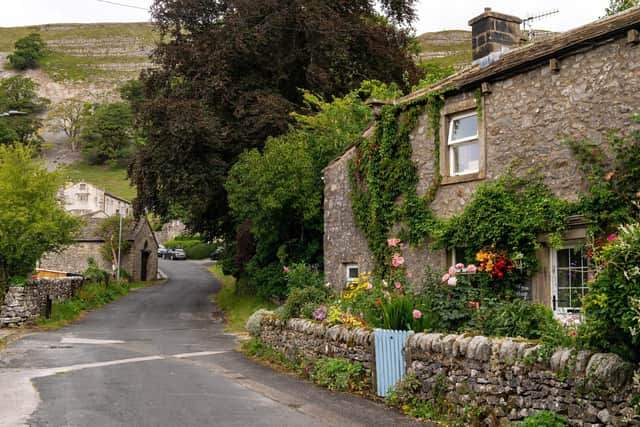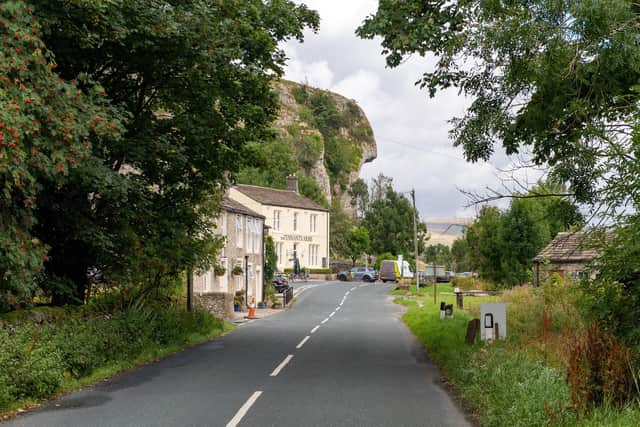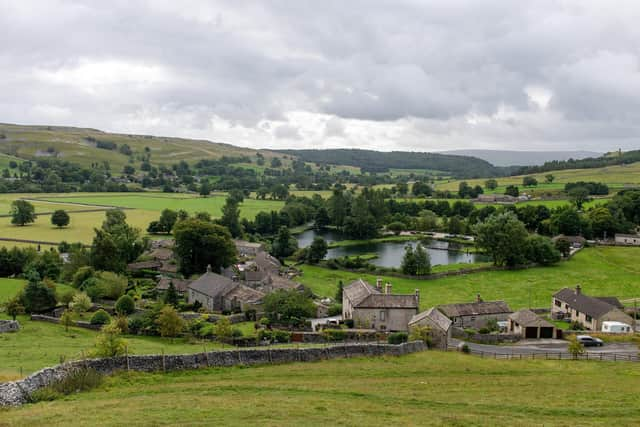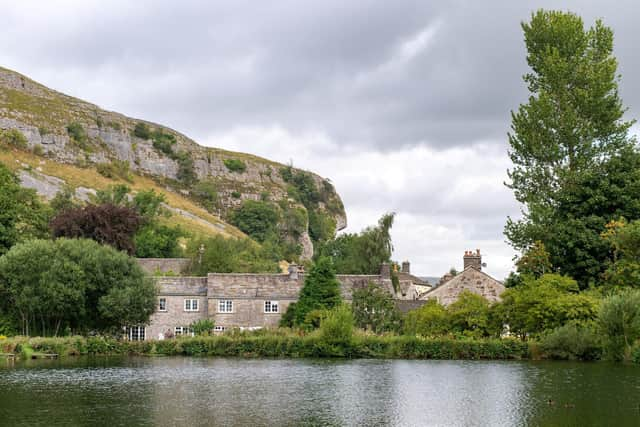Yorkshire Village Focus: Kilnsey - crags, shows and local spirit in a 'place where history feels alive'
He started at first light, when there was no traffic on the road below and the only accompaniment to him scaling that imposing 170ft cliff, with its forbidding 40ft overhang, were the cries of Wharfedale’s moorland birds.
Hardly any of the past 20 summers have passed without Dave, 46, from Sheffield, booking somewhere to stay in the Dales, usually a few miles up the road in Grassington, and returning to Kilnsey, where the climbing bug really bit him.
Advertisement
Hide AdAdvertisement
Hide Ad“Well, it’s just exhilarating, isn’t it,” said Dave. “I reckon I know it as well as anybody, but there’s always something new, something you didn’t quite expect when you set out. Technically, it’s tough and that’s what really gives you a buzz when you get to the top. It doesn’t matter how often you tackle that overhang, it’s always a challenge.”


There’s always going to be a new challenge on the crag, even for old hands like Dave. The UK Climbing website lists more than 200 routes up it, many with picturesque names, among them Round the Mulberry Bush, Softie’s Adventure, Man With a Gun and Jump Leads to Wise Blood, as well as more straightforward descriptions, including Kilnsey Main Overhang.
Dave has plenty of advice to offer a couple of fellow climbers just arriving for their first ascent and weighing up the sheer cliff face that has defied generations to scale it.
Darren Howe and Paul Chadwick, from Birmingham, are in the Dales to tackle Kilnsey and the two other great limestone crags, Malham Cove and Gordale Scar.
Advertisement
Hide AdAdvertisement
Hide AdKilnsey’s first on their list. “We’ve heard a lot about it,” says Paul. “So this year we decided to do Yorkshire’s big three. Can’t wait to get started. It’s just magnificent and the countryside is breathtaking.”


Thousands of visitors every year would agree with him, as would the residents of Wharfedale who count themselves fortunate to live in such glorious surroundings.
Kilnsey Crag is one of the great defining emblems of Yorkshire. The wider world became aware of its majesty when J M W Turner painted it in 1816, and almost two centuries later, millions marvelled at it on television when the 2014 Grand Depart of the Tour de France sped past on its way through the Dales, the crag creating the most dramatic of backdrops to the greatest of all cycle races.
And the crag defines its village too. Kilnsey nestles below it, compact and charming, its stone houses seemingly as timeless and immovable as the rock itself.
Advertisement
Hide AdAdvertisement
Hide AdIt is amongst the smallest of Dales villages, where visitors touring the area can almost pass through without realising it, unless they intend stopping at Kilnsey’s only pub, the Tennants Arms.


But there is one event in Kilnsey’s calendar that makes it a destination for thousands.
Kilnsey Show celebrated its 125th anniversary this week. Since 1897, it has marked the end of summer in the Dales, its showground spread out below the crag on the Kilnsey Park estate and its programme as much a draw for families as it is for Wharfedale’s agricultural community, with livestock classes, equine events, sheepdog trials and the best of artisan foods.
And of course, there is the crag race, still a centrepiece of the show as it was at the end of the 19th century. In contrast to the climbers who make painstaking ascents over the course of several hours, competitors in the race are set on achieving record times for the 1.2mile route which climbs a gruelling 330ft before the dash back down.
Advertisement
Hide AdAdvertisement
Hide AdChris Windle has been the show’s chairman for the past four years, after serving as vice-chairman for two years before that.


The show was one of the relatively few to take place in 2021 when the pandemic put paid to many agricultural events, and a crowd of 13,000 came through the gate.
It’s an event that brings the community of Kilnsey, its closest neighbour, Conistone, on the opposite bank of the River Wharfe, and surrounding villages together.
Chris said: “It means an awful lot to the community. The way I gauge that is by the number of local people who throw themselves behind the show in all sorts of different way. On the Sunday before the show and the Sunday after we have a lot of people turn up to help with the infrastructure, building sheep pens and the main ring.
Advertisement
Hide AdAdvertisement
Hide Ad“There were about 30 of us turned up, all volunteers and then at lunchtime we all went to the Tennants Arms for lunch and then we went back and did some more, until about seven o’clock.
“A lot of people put time into it in different ways. They might be stewards on the day, and all these roles are taken by local people.
“It’s more than a village event, it’s a community event. Kilnsey is only a small place, but people come from all the surrounding villages and from Grassington and Skipton.”
History feels very alive in Kilnsey, and not only because of the timeless appeal of the crag to generations of climbers and walkers. The village’s angling club, established in 1840, is the second oldest in the country, fishing along 18 miles of the Wharfe, the Skirfare, Oughtershaw Beck, Greenfield Beck and Cray Gill.
KILNSEY FACTS
Advertisement
Hide AdAdvertisement
Hide AdKilnsey’s roots go back a very long way. Its name is probably derived from the Old English “kiln by the marsh” and the Kilnsey Estate dates back to the 1100s, when monks from Fountains Abbey farmed sheep there.
The Roberts family have lived on the estate since 1911, when Sir James Roberts bought it after making his fortune from wool. He was a noted philanthropist who donated the Haworth Parsonage, home of the Brontes, to the nation.
The estate is now a centre for outdoors activities, including fishing and horse riding, as well as being home to a red squirrel conservation programme. Its website is kilnseypark.co.uk